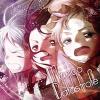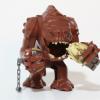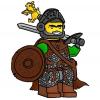Search the Community
Showing results for tags 'gondola'.
Found 13 results
-
[MOC] 1:22,5 Scale - G Gauge (45mm) - Toy Locomotive (Mark II) and new LGB-based "gondola" wagons
Paperinik77pk posted a topic in LEGO Train Tech
Hi all! Here we go again with big Lego trains running on 45mm G Gauge track! Some of you may remember the yellow Toy Train locomotive I prepared back in 2019 -it was one of my first experiments with G-Gauge trains. This little locomotive was based on a small Powered-Up battery box and a Medium motor. Here it is during a night run on the new 45mm copper track with wooden sleepers I restored to be used on my small garden railway. Here's a detail of the old chassis with the original 1,667:1 gear ratio. This solution proved to work fine on a flat track at home, but was completely useless on the garden line, which can be easily considered a "mountain railway". A 3:1 gear ratio worked better, but gears were too stressed and speed was ridicolous. Plus, with some wagons, the motor always needed to work at full speed. Therefore, back to the lab, I completely revisited the heart of the locomotive, and updating some details on the exterior. Here it is, the Mark II (TADAAAAAAA) !!! And...what's new??? Actually, at body level, it did not change so much from the older one . Handle bars, and headlights have been modified and a new exhaust scoop has been added over the hood (there's no more a red On/Off button). The real new part is under the bodywork: A completely new chassis has been introduced, and now features a new 4-ports PuP Hub and a more efficient Large Motor. Gear ratio is now 2.779:1. It is very strong and smooth - the big battery/bluetooth hub helps traction (which can be increased with the use of rubber bands around the wheels), and the L-Motor is a great improvement over the M-Motor. I've prepared some workflows on the PuP application to work at 25/50/75/100% of the power. The chassis can be detached from the body with four "fast unlock" pins, so changing the batteries is now an easy task. Then, with a locomotive now up to the task of garden railroading, I needed some rolling stock. I've some LGB wagon bases with studs on top (item number 94063) which are the perfect chassis for some wagons I've designed in Stud.io. Both axles are steering, to help the wagon working on tighter curves. So here it is the small gondola , in a bright blue color: And the tan/beige gondola with taller sides: The LGB chassis runs smoothly and really helps the whole train to roll better. Sometimes these things are available (used or new) with an acceptable price, so I get them. A final photo of the consist (fat least for the moment)! Next to come, a passenger and a closed freight wagon with sliding doors (let's see who comes first). I'll try it on the garden railway soon and give some feedbacks (for now only some pretty satisfactory tests were conducted on homemade ramps) I hope you like it!!! Ciao! Davide -
Nexus Force ALCO RS-11 diesel loco with freight train - LDD MOC (so far)
Murdoch17 posted a topic in LEGO Train Tech
A utilitarian space / Arctic freight train for my ice-bound Nexus Force base... it may not look very spacey, though. (I tried, it's more difficult than it looks!) This MOC features: - ALCO RS-11-like four axle diesel loco - boxcar with removable top and opening doors. - Nuclear waste flask car. Try not look at the glass sections for very long! - two couple of sectioned gondolas loaded with comet / meteorite samples.... and maybe a few frozen aliens inside! - bay window caboose for nuclear flask guards and train crew This model was originally a ALCO MRS-1 (which you can see in his instructions store here) built by @SavaTheAggie, but has been so severely modified that it no longer looks like the prototype loco. So I went searching and found another ALCO locomotive, a RS-11 that looks (kind of) like my new loco. Both my MOC and the new prototype have the four wheels, and the same basic hood and cab design as the MRS-1 that preceded it. I changed out the original grille bricks at the rear for grille tiles SNOTed-in sideways for a more consistent look when compared to the roof vents. I added back in Sava's maintenance cabinets from the MRS-1, yet attached them differently using newer parts. I also shortened the frame by six studs to fix the spacing problem created by the missing two wheels. The long hood of the loco has been designated the rear. The printed Nexus Force logo (from CITY Arctic 2014) goes on the curved 2 x 2 x 2/3 slopes on the front and rear hood ends, underneath the lights. This boxcar was heavily inspired by Time Gould boxcar design from the dying days of the 9v-era, otherwise known as 2008. (You can see it and his entire vintage train it came from, here on Rebrickable for free.) The roof comes off this car type and the loading doors open up. This nuclear waste flask car is loaded and ready for delivery to a waste storage facility at an undisclosed location. These open air gondolas are loaded with icy meteorite fragments, which may or may not contain hostile alien life frozen inside! No interior on this part of the train, as it's too crowded inside due to needed SNOT-work for the bay windows. This car was originally puzzled-out from this MOC's pictures. I'm already parting out the diesel engine, but the train will have to wait. You can see more details on the arctic / space base shown above in this thread in the Sci-Fi forum. Be warned, it needs to be updated with some newer stuff I designed! Thoughts? EDITED 9/6/21: added nuclear car photo and updated the main picture.-
- transporter
- waste
- (and 13 more)
-

GBC Detachable Cable Car / Chairlift
juggleman posted a topic in LEGO Technic, Mindstorms, Model Team and Scale Modeling
Here is my Detachable Cable Car / Chairlift / Gondola / Funicular - GBC (great ball contraption) based on Pierre Georges's brilliant design. -
[MOC] Chilean "Gondola Carril T-1024" in 1:22.5 scale
Paperinik77pk posted a topic in LEGO Train Tech
Hi all, today I'd like to show you something I'm after since a few months. During the first days of lockdown I saw a documentary on Chile and its people, towns, traditions and lifestyle. One of the main points of the documentary was focusing on the railway running from Los Andes to Rio Blanco valley , a spectacular run between mountains, aside the Rio Blanco river. Originally it connected Chile to Argentina. And this "thing" was presented as the main attraction of the current line - its name is "Gondola Carril T-1024". I sincerely do not know why it is called "T-1024" . The "Gondola Carril" is a railmotor, based on an American built bus, the Yellow Coach Z-26. This time I understood that the letter Z is identifying the chassis type and 26 the number of passengers it could carry . The bus was normally used in Los Andes town, until it was converted into this very nice railcar. Originally used as a cheap inspection vehicle, It is now fully restored and used for touristic travels. And I can say it is an experience I would like to do once in my life. The "Ferrocarril Transandino de Chile" is a narrow gauge (metric) railway, therefore I based the whole project on 1:22.5 scale (good for running in the garden!). It is designed to run on G-Scale track (45mm), but with some modifications it could easily be converted to run also on standard Lego gauge (on large curves, since it is quite long). Since there are no specific technical specifications for the Gondola, I searched for the ones of the Z26 Bus - and tried to adapt the design according to the pictures and videos of the real railcar. The original motor used by Yellow Coaches Bus was replaced by a more modern Cummins Diesel, as nicely "declared" above the radiator. Despite the original railcar is based on a chassis, this one is basically a unibody build with some underside reinforcing (let's say - like the Jeep Cherokee XJ). It's quite light, so a medium motor is sufficient to move it. In the design, I used a PuP motor, placed in the front, under the hood. Then a pair of gears in cascade, cardanic joints and a transmission axle bring the power to the rear wheels. The "gears" I mentioned can be changed easily to have a lower or higher gear ratio, as needed. This railcar not meant to pull anything, so a lower gear ratio could save some batteries. Battery box is placed in the rear part, immediately beyond the rear axle. The small red axle you can see near the T-1024 sticker is used to turn the PuP battery/receiver on and off. The next picture shows the powertrain - it's taken from an alternative blue version of the railcar I prepared , with some freelance solutions which make it more "generic". I hope you like this one, and (more important) take a look to the original one, because it's really nice piece of history. https://www.ferrocarril-trasandino.com.ar/historia/ Ciao! Davide -
1930's freight train with 1898-style 4-8-0 Mastodon steam locomotive - real life MOC
Murdoch17 posted a topic in LEGO Train Tech
It is the early 1930's. The dark days of late 1929 has worsened into a economic depression of truly epic proportions. Worse, the drought starting in summer 1930 (lasting until above average rains stopped it in 1941) caused the dreaded Dust Bowl and the mass migration of (most) of an entire generation of farmers and their families westward. This time frame also led to the rise of hobos, wandering, jobless people trying to use the one mass transportation still running across the dusty, windswept nation: The freight trains. The backstory on this train is as such: The engine, number 6519, runs daily from Lawrence, Kansas yard to where it finally services the Rust-eze factory in Moberly, Missouri. The line branches off and curves to the left in Columbia Missouri, while the main goes straight on to St. Louis. The rest of the regular freight is worked at the Columbia yard, expect for the acid tanker and the two marked generic boxcars. That tanker goes to the factory too, as it's a chemical component for Rust-eze. Rumor has it that the Rust-eze plant will be moving closer to St. Louis, or even shutting down soon, maybe by early 1934. The engine used to be a heavy-hauler out on the main, but has been relegated to branch line work, as it's 1898-vintage pistons are wearing a bit thin and she is overdue for a overhaul. Unfortunately, with the current depression, she has been reassigned to light branch work with a limit on her speed. Hopefully, they will scrape up the money to get her in the shop soon. This early 1900's-era engine model was first designed as a 2-8-2 Mikado before having the front pony truck removed and a 4 wheel bogie from set 10194 (Emerald Night) added instead, turning it into a 4-8-0 Mastodon - type. The rear pony truck was removed as well, with the 79111-style boiler shortened and cab re-arranged. Then, as of late September of this year, I completely rebuilt her from the wheels up to use the Disney engine boiler you see here. The running gear was originally a Scotnick invention from his 9F, but now comes from my MOD of the Constitution Train Chase set. So, basically, the only thing original left is the tender. Together, these several different engines from four different eras and five separate builders come together to create this one steam engine, which I have numbered 6519. The coal tender was inspired by Anthony Sava's Pacific 4-6-2 model's oil tender with the letters "BRS" added in the middle of the tender using printed 1 x 1 tiles. I was inspired by this photo by JB Lego to build this boxcar as seen here. They are made to haul pallets of cargo, specifically Rust-eze chrome restorer in 55-gallon drum containers for commercial packaging at this facility into smaller containers. Inspired by the green tractor trailer from CITY set 4204 (The Mine), this bathtub gondola is carrying boulders from the mine destined for the gold refinery where they will be opened up and the metal extracted to make coins and ingots. This drop side flat car was first part of set 2126 (Train Cars), but it didn't really have a purpose. It was hauling uprooted evergreen trees in the set, but that didn't look very good, so I changed it to generic freight. (My layout's resident hobo and his trusty guitar usually catch a ride on this piece of rolling stock.) The hobo is trying to get home to his family, which lives in Glenncoe, Missouri. Sadly, he picked the wrong train, as this only get's him halfway there. He's going to have to ride the blind of a steam engine tender on a passenger run to get home. (that's the area between the first car and tender, it's very dangerous because you're balancing on the coupler!) This dangerous liquid tanker was modeled after a real tanker car you can walk through in the Museum of Transportation's collection in St. Louis, Missouri. The real deal hauled hydrochloric acid for Monsanto starting in 1940 up into the late 1960's. I'm backdating the car ten years to fit into my mid-'30's freight train. I have adapted this UK inspired model of a brake van by Fireglo450 (see it here) to once again be a more American-inspired caboose. The caboose has no interior, and the red marker light can go on either end of the model to represent the end of whatever train it is being hauled behind. Here you can find other topics of interest mentioned in the text, or that are similar enough to be placed alongside time frame-wise I have this passenger train, that goes along with the freight train in this time period. (No, the hobo does not ride this one home.) and this branch-line station that is from the same late-1890's era, and on the main line from the San Francisco to New York (via St. Louis, of course!) Here we see the (100% fictional) Moberly, Missouri, Ruste-eze Factory. It seems to have made it to better times, with this picture taking place in the early 1950's. Any thoughts, comments, or complaints? -
Unit Coal Train at Brickworld KC 2019 Loading_Station_BWKC_2019_01 by Terry Akuna, on Flickr Loading_Station_BWKC_2019_02 by Terry Akuna, on Flickr
- 3 replies
-
- brickworld
- kcbl
- (and 12 more)
-
These are the coal gondolas that are used with my unit coal train as part of my coal train facility. Each car can hold one large PAB cup worth of material. Coal Gondolas by Terry Akuna, on Flickr Coal Gondolas by Terry Akuna, on Flickr Coal Gondolas by Terry Akuna, on Flickr Coal Gondolas by Terry Akuna, on Flickr
- 5 replies
-
- coal train
- coal hopper
- (and 9 more)
-

Lego technic Ropeways
XG BC posted a topic in LEGO Technic, Mindstorms, Model Team and Scale Modeling
Hello guys I thought I would open a new topic to show off all of the beautiful chairlifts/gondolas/ropeways that you guys have built. I will include everyones flickr youtube and so on in this post. @PG52: https://m.youtube.com/user/pg5200/videos @Elias Iten: https://m.youtube.com/user/eliasiten/videos @dagupa: https://m.youtube.com/channel/UCuDz-_Yhx43imV7QJV3Eaag/videos Tailgunner088: https://m.youtube.com/user/Tailgunner088/videos antoine ddp: https://m.youtube.com/channel/UC7bVmCheE-a9DTFZN3HKRrg/videos @PistenBully 600 : https://m.youtube.com/channel/UCN_lVkaX3dTrMEnnlwQGbpw/videos The Timmy376: https://m.youtube.com/user/TheTimmy376/videos aylac: https://m.youtube.com/channel/UC86hWT9xGcqNbSiZXl2T3Fg/videos Im shure there are many more out there so this will never be complete but be shure to show me more so I can include them/you in this post. also feel free to ask anything about how to build lego ropeways! XG BC -
Similar to my thread of a year ago, wanted to share a couple more freight cars I've been building on the side: Conrail N6A I've shown this Conrail transfer caboose in a couple of my threads, but never formally, so here it is. The prototype is one of several classes of transfer caboose Conrail inherited from the Penn Central. The model was designed almost two years ago, and I got around to putting it together last year. The "skirt" that covers the tops of the wheels is typically the toughest thing to model on American freight cars: if you run on R40 track, the bogies usually need to pivot enough such that the wheels will scrape... this isn't a problem on the N6A because it's quite short; no fancy engineering is required to compensate! The geometry of the skirt and such are still similar to that of my earlier flatcar. And with stickers Brickshelf Gallery PRR G43 Like the caboose, this gondola might have shown up a few times, but never formally. The G43 is a 52' gondola built during the last decade of the PRR. Most of them went to PC and then Conrail. This model was designed and built last year. The dimensions are very similar to the aforementioned flatcar, and it's basically built the same way: the structural component (the sides) is studs-out, and the floor and trucks are studs-up. Once again, much of the work done to make the skirts work on the flatcar are applicable here. Thus, the hardest thing here was figuring out what to do about the shallow trapezoidal part in the middle - eventually I went with wing plates. Finally, this probably should have been dark red or reddish brown, but all three colors seemed to somewhat off, so I ended up going with the most common. I also looked at weathered designs, but its a little bit too difficult when there are a lot of large, exposed parts like the wings. Brickshelf Gallery Alaska Railroad 15800 Series This is a side-dump car, typically used for MoW work. Technically Wikipedia thinks its a type of gondola. As you can see, the specialized feature of this type of car is that it empties sideways: unfortunately the model does not have this feature! This car has actually never been posted: I only recently completed the design and model: Doing the textures on the sides was a little big challenging, especially trying to "blend" it with the ends. On the prototype there are a ton of funny angles that are hard to model in LEGO. Construction is otherwise typical: studs-out for the body, studs-up for the chassis. Those droid-body things are really good for the big pneumatic pistons. Brickshelf gallery Finally, this is a repost, but here is the gondola and caboose running with my EMD Model 40:
- 7 replies
-
- american
- rolling stock
-
(and 4 more)
Tagged with:
-

[Feedback requested] [Instructions] [MoC] "International" Gondola
jtlan posted a topic in LEGO Train Tech
Those of you with good memories may remember this gondola: It first appeared in the thread for @Commander Wolf's T18, and has since appeared in various videos of our locomotives. The gondola is a relatively straightforward design, being a modernized version of the body from 4543 Railroad Tractor Flatbed mated to trucks from the My Own Train series of cars (10013, 10015, 10016, 10017). Besides being pleasantly "official" in style, the design is fairly international; we liked it because it looked decent when paired with locomotives from various parts of the world. I've gone ahead and made instructions for this model: You can get them in PDF form below: International Gondola (PDF) In exchange, would you mind giving me some feedback on the instructions themselves? For example, are they easy to follow? What don't you like about them? etc. Enjoy! P.S. If you prefer images to a pdf, there is a Brickshelf gallery here (pending moderation). -
Presenting my hi-rail exacavator. It is a fun little creation I put together for an upcoming LUG meeting at train themed brewery. It is driven by the rubber tires mounted to a PF train motor. The battery box and IR receiver are located in the high side gondola. It is made to stand up to children playing with it. I got the inspiration from a picture of the LEGO display at LEGO World. A designer took the 4203 set and put it on rails. I don't think he/she used a train motor since his/her wheels are spaced much further apart. He/she also used a box car with draw bar. I think a gondola would make more sense to pair with an excavator to dump material into. Hi-rail Excavator by dr_spock_888, on Flickr Here it is running on some tracks: I morphed it from this originally:
-

detachable 3S-Ropeway with 16 motors (Version 2.0)
Elias Iten posted a topic in LEGO Technic, Mindstorms, Model Team and Scale Modeling
While skiing I had the idea to reproduce an entire detachable ropeway just with LEGO-Technic-Bricks. After 400 hours of developing, testing and programming the model was built from scratch without any construction plans. This ropeway is an improved version of my first ropeway 2 years ago ;) This model-ropeway works just as its real brother. The eight gondolas are detached in the stations and slowed down to let passengers board easily. But not just the cable-clamp-mechanism is realized like in real ropeways but also the rope tensioner. This mechanism keeps the haul-rope always tensioned by the information of the sensors. Other sensors supervise the distance between the gondolas and adjust it when needed by slowing down a specific motor. Also the haul-rope is monitored by sensors. If the rope falls out of a deflection pulley the whole system performs an emergency-stop. The entire model and even the whole control system with sensors and processors consists of usual LEGO-parts and is driven by 16 motors in total. Along with about 300 gears and 1‘000 chain-links, 10'000 parts were needed. Pictures of the building process can be found on Facebook Next year I plan to build an intermediate station with another 6’000 parts. The whole ropeway-model then will be powered by 30 motors, 4 Mindstorms-Computers, 15meters of technic-chain-links and about 500 gears.- 45 replies
-
- detachable
- ropeway
-
(and 8 more)
Tagged with:
-
Here's my entry to the Varlyrio challenge. Inspired by de Gothia, MikeyB, and everyone else who has built in Varlyrio. This was a ton of fun to build and I hope you like it All C&C welcome
- 16 replies
-
- Varlyrio
- Mitgardian
-
(and 4 more)
Tagged with:



